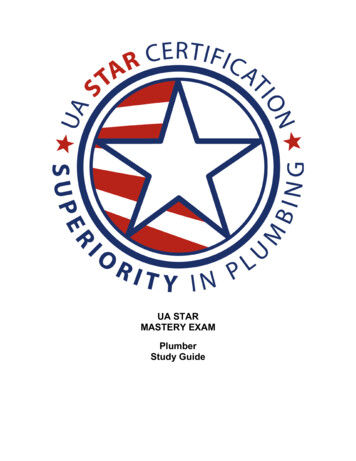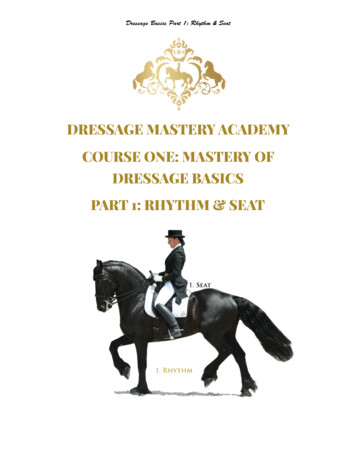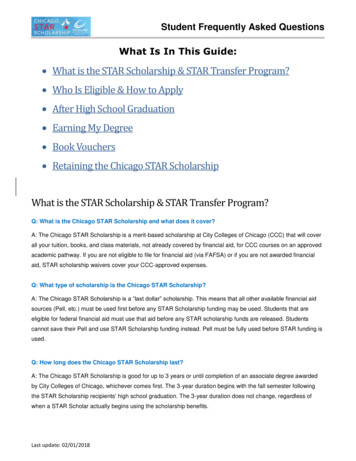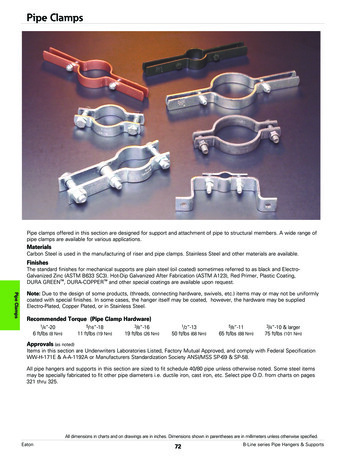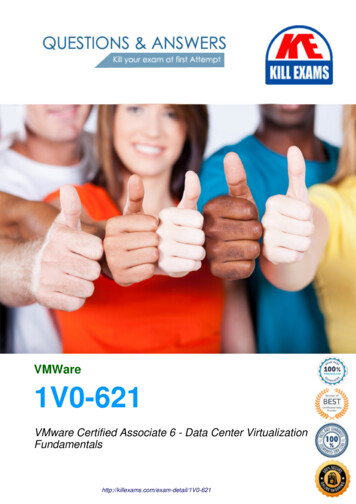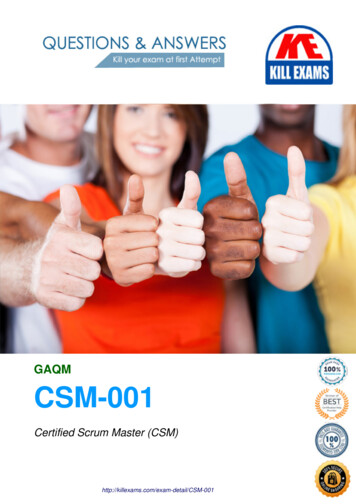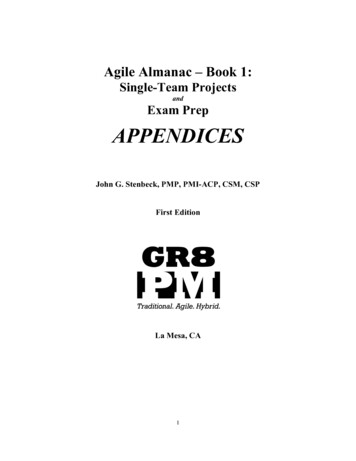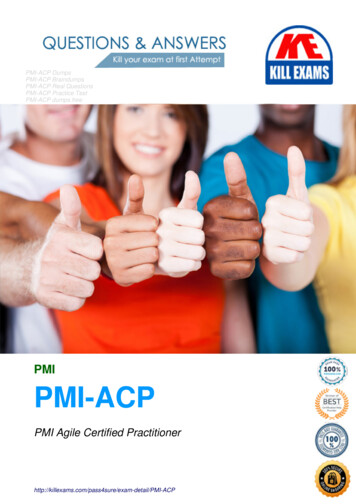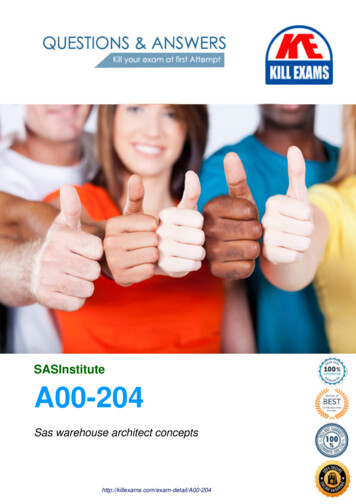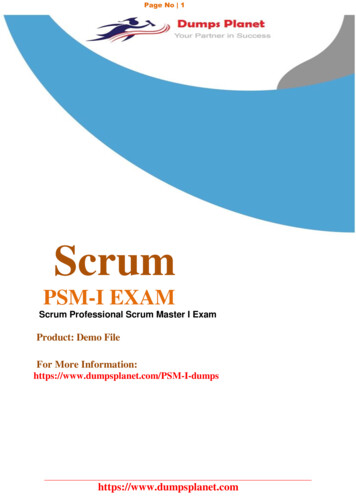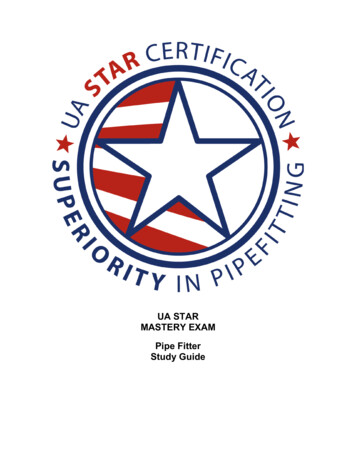
Transcription
UA STARMASTERY EXAMPipe FitterStudy Guide
International Pipe Trades Joint Training Committee, IncGeorge H. Bliss, III, PresidentPresidentUA Director of TrainingCharles “Buddy” Parkes, ViceJohn Moore, SecretaryBusiness Manager – UA Local 254Cornelius J. Cahill, Vice PresidentNFSA RepresentativeD. David Hardin, TreasurerMCAA RepresentativeBradley Karbowski, Vice PresidentBusiness Manager – UA Local 669Karl M. Bykowski, DirectorUAC/PHCC-NA RepresentativeLogan Dockter, DirectorBusiness Manager – UA Local 300James F. Lynch, DirectorNFSA RepresentativeWilliam Rodger Grimes, DirectorMCAA RepresentativeUAC/PHCC-NA RepresentativeTony Fanelli, DirectorCanadian Mechanical & IndustrialInternational Pipe Trades Joint TrainingCommitteeGeorge H. Bliss, III, Chairman – UA General OfficeCharles “Buddy” Parkes, Vice Chairman – UAC/PHCC-NAD. David Hardin, Vice Chairman – MCAAEric L. Packard, Secretary – UA Local 669Members:Karl M. Bykowski, UAC/PHCC – NAJerry Miller, UA Local 597Cornelius J. Cahill, NFSARobert L. Cross, UA Local 68William Rodger Grimes, MCAATalmadge Graham, UA Local 420James F. Lynch, NFSATony Fanelli, Canadian Mechanical &Industrial Contractor Rep.Ronald Townsend, UA Special RepresentativeCanadian Representative for Committee1
CONTENTSInternational Pipe Trades Joint Training Committee, Inc .1International Pipe Trades Joint Training Committee .1CONTENTS .2ACKNOWLEDGEMENTS 3FORWARD .4UNITED ASSOCIATION REFERENCE BOOKS .5CategoriesA. PIPING AND TUBING 6B. BLUEPRINT READING . 8C. MATHEMATICS AND MEASUREMENT 9D. SAFETY . . .10E RIGGING . .11F STEAM SYSTEMS . . . .11G. INSTRUMENTATION AND PNEUMATIC CONTROLS . 12H. WELDING .13I. HYDRONICS . 13J. REFRIGERATION AND AIR CONDITIONING .14K. PUMPS . .15STUDY GUIDE QUESTIONS .15 - 31ANSWER KEY .32 - 342
ACKNOWLEDGEMENTSThe International Pipe Trades Joint Training Committee, Inc., wishes to acknowledge thefollowing persons for their contributions in the development of this Study guide, which wasdeveloped under the direction of George H. Bliss, III, Director of Training, UnitedAssociation Training Department, Steve Allen, Assistant Director of Training UnitedAssociation Training Department, and Michael P. Arndt, Technical Consultant, UnitedAssociation Training Department.The authors of this study guide are Bob Harris, Training Director Pipe Fitter Local Union420 Philadelphia, PA, Steve Sweeney, Instructor, Pipe Fitter Local Union 420 Philadelphia,PA and Harry Plummer, Pipe Fitter Local Union 420 Philadelphia, PA3
FORWARDThe International Pipe Trades Training Committee and the United Association TrainingDepartment have developed the following Study Guide to assist you in locating information inUA textbooks, which relate to the 11 categories and 28 tasks identified during the DACUM(Develop A CurriculuM) process administered by Ferris State University. The DACUM is an indepth job and task analysis, which serves as the base for the UA STAR exam.The 12 categories and 44 tasks identified during the DACUM are included in this Study Guideso that you see, first-hand, the results of the study and the items that you can expect to encounteron the UA STAR exam. Each category and task is numbered, and each task is broken into anumber of smaller jobs, which a pipe fitter would be expected to perform in order to completethe task.Below each task you will find an underlined paragraph that looks like this and containsgeneral reference to UA textbooks.You will find that the UA STAR exam is a comprehensive exam. It is designed to test theknowledge of the experienced pipe fitter. As such, this Study Guide is not intended to be areference for the inexperienced pipe fitter to use in preparing for the exam. It is not expectedthat the inexperienced pipe fitter will be able to successfully compete the exam based on theStudy Guide and the information contained in UA textbooks.It is expected that the UA STAR test candidate is the pipe fitter who has completed the UAtraining and has gained several years of experience in the field. Many of the tasks and jobsidentified in the DACUM are those, which can only be learned by doing. The test candidate,who expects to achieve success on the UA STAR exam by merely using the Study Guide to locateinformation in textbooks, will likely be disappointed.It is recognized that even the best pipe fitter does not work in all areas of the industry. Further,some knowledge can be forgotten through lack of use. As such, it is recommended that youstudy a number of UA textbooks in preparing for the UA STAR exam. A list is provided belowthis paragraph. These texts were cited throughout the Study Guide. You may wish to reviewthose texts where you feel you need knowledge. In addition, there are many other excellentbooks on the market, which can serve as reference for you. They are far too numerous to list.You may know of some of them or even own them. Feel free to use them in your studies.4
UA textbooks use as reference in this Study GuideAdvanced Plan Reading and Related DrawingAir ConditioningGas Tungsten Arc-WeldingHydronic Heating and CoolingInstrumentation and Process ControlJob Safety and HealthPipe BendingPipe, Fittings, Valves, Supports and FastenersOxy-Fuel Cutting and Welding and Shielded Metal-Arc WeldingPneumatic ControlsPumpsRefrigeration (2 volume set)Related MathematicsRelated ScienceRiggingSoldering and BrazingSteam SystemsPiping Handbook and Offset FormulasSome UA textbooks contain questions, which provide excellent practice material and act as alearning tool. If you spend time and answer the questions at the back of the texts successfully,you will improve you chances of success on the UA STAR exam.This Study Guide also contains practice questions. All questions are multiple choices, with fourpossible answers. Most questions contain explanations for each of the correct and incorrectanswers. The questions are designed to help you review some of the material that you will needto know when taking the exam.The UA STAR exam is a tough test. With some hard work, you can be successful in passing it.Good luck!5
Category A:Task 1.Piping and TubingCut and join steel, chromium and stainless pipeMeasure steel pipeCut steel with torchCut with saws (band, hack, reciprocation, etc.)Cut with pipe cuttersLift with proper lifting equipmentJoin steel pipe to steel using flanges, welding, threadJoin steel pipe to copper using dielectric fittings and threadJoin pipe using grooved endsPrepare ends of pipe appropriately per joining process and properly fit themIdentify percentage of chrome in pipe in order to determine proper cutting methodReferenceInformation of these procedures can be found:Pipe, Fittings, Valves, Supports and FastenersOxy-Fuel Cutting and Welding and Shielded Metal-Arc WeldingTask 2.Cut and join copper pipe and tubingMeasure copper pipeCut using various methods: tubing cutter, saws, etc.Identify class of copper piping and tubing (K, L, M, etc.)Join copper to various pipes: copper, brass, steel, etc.Join using various methods: soldering, brazing, welding, thread, compression,dielectric, flaring,etc.Prepare ends appropriately including cleaning and reamingBend copper tubingReferenceInformation of these procedures can be found:Soldering and Brazing6
Task 3:Cut and join plastic pipeMeasure pipeCut using various methods: tubing cutter, saws, etc.Identify types of plastic piping (PVC, CPVC, ABS, etc.)Join plastic to various pipes: copper, brass, steel, etc.Join using various methods: gluing, welding, thread, etc.Prepare ends appropriately including cleaningReferenceInformation of these procedures can be found:Related ScienceTask 4:Hang pipe using pipe hangers, supports, anchors, guides and fastenersIdentify various types of pipe hangers and clamps: clevis, roller, beam, etc.Use various pipe guidesInstall pipe anchorsIdentify types of joints: welded, screwed, flanged, etc.Cut using various methods: tubing cutter, saws, etc.Identify class of copper piping and tubing (K, L, M, etc.)Join copper to various pipes: copper, brass, steel, etc.Join using various methods: soldering, brazing, welding, thread, compression,dielectric, flaring,etc.Prepare ends appropriately including cleaning and reamingBend copper tubingReferenceInformation of these procedures can be found:Pipe, Fittings, Valves, Supports and FastenersTask 5:Install expansion jointsIdentify various expansion jointsIdentify need for expansion jointsProperly install and anchor expansion joints7
ReferenceInformation of these procedures can be found:Related ScienceSteam SystemsHydronic Heating and CoolingTask 6:Install valvesIdentify types of valves: gate, globe, ball, relief, check, butterfly, mixing,diverting, control, etc.Select appropriate valve for the application: positive shut-off, throttling, etc.ReferenceInformation of these procedures can be found:Pipe, Fittings, Valves, Supports and FastenersTask 7:Perform pipe fabricationDetermine scope of jobSecure and interpret appropriate drawing of sketchCreate scaled drawingCreate templates if necessaryMeasure pipeJoin piping material as specifiedIdentify locationInstall pipeReferenceInformation of these procedures can be found:Advanced Plan Reading and Related DrawingPiping Handbook and Offset FormulasCategory B:Task 8:Blueprint ReadingIdentify piping symbolsIdentify size of pipingIdentify direction of flowIdentify valves, fittings, etc.8
ReferenceInformation of these procedures can be found:Advanced Plan Reading and Related DrawingTask: 9Interpret blueprintsIdentify basic blueprint symbolsIdentify basic mechanical symbols: valves, motors, etc.Identify welding symbols: fillet, butt, etc.Identify common architectural symbols: walls, doors, etc.Interpret blueprintsIdentify different types of drawings: orthographic, isometric, etc.ReferenceInformation of these procedures can be found:Advanced Plan Reading and Related DrawingCategory C:Task: 10Mathematics and MeasurementPerform basic math operations for pipe fittersIdentify correct math formulas for given problemsUse of: calculator, compass, protractor, ruler, etc.Calculate: volumes, areas, pressure, force, mechanical advantage, etc.Calculate piping problems: fitting take-offs (90 , 45 , odd angles),Equal spread offsets, unequal spread offset, rolling offsets, etc.Measure: elevations, pipe diameters, pipe schedules, etc.Reading: ruler, tape measure, transit, level, etc.ReferenceInformation of these procedures can be found:Related MathPiping Handbook and Offset FormulasTask: 11Demonstrate knowledge of related scienceVolume, density, force, pressure, thermal expansion, heat, temperature, buoyancy,Specific weight, absolute pressure, standard temperature and pressure, specific heat,Heat transfer: conduction, convection and radiationReferenceInformation of these procedures can be found:Related Science9
Category D:Task: 12SafetyDemonstrate knowledge of high-pressure safetyIdentify potential hazardsLocate causeTake corrective actionReferenceInformation of these procedures can be found:Job Safety and HealthTask: 13Demonstrate knowledge of OSHA regulationsIdentify: potential hazardsDemonstrate: applicable regulationComply: with regulationsconfined spaces, lock-out tag-out, fall protection, riggingscaffolding and ladders, trenching, personal protective equipment,electrical safety, proper storage and handling of hazardous materials,hot-work permits, accident reports, etc.ReferenceInformation of these procedures can be found:Job Safety and HealthTask: 14Demonstrate knowledge of basic safety principlesIdentify potential hazards, personal protective equipment requiredComply with shop and equipment safety rulesApply basic emergency and first-aid techniquesUse of tools, equipment, materials, etc.ReferenceInformation of these procedures can be found:Job Safety and Health10
Category E:Task: 15RiggingOperate lifting and moving equipmentOperate: chain falls, jacks, portapowers, pry bars, come-alongs, etc.ReferenceInformation of these procedures can be found:RiggingTask: 16Perform riggingDetermine: weight of the load to be lifted, appropriate lift pointsSelect lifting devices: slings, chokers, block and tackle, come-along,Tag lines, chain hoist, etc.Identify: hazards (electrical lines, populated work areas, accessibility,Damaged lifting equipment, etc.)Perform proper communication with crane operator: (hand signals,Radio contact, etc.)ReferenceInformation of these procedures can be found:RiggingCategory F:Task: 17Steam SystemsInstall steam trapsIdentify: piping requirements for each type of trapIdentify: different traps (impulse, inverted bucket, float, thermostatic, etc.)ReferenceInformation of these procedures can be found:Steam SystemsRelated Science11
Task: 18Install condensate piping and tanksIdentify: function and operation (condensate pumps, traps, etc.)Identify: parts of steam piping system (mains, drips, expansion joints, risers, etc.)Identify: types of heat transfer equipment (convectors, exchangers, coils, etc.)Maintain: piping, valves, traps, etc.Install: piping and tanksReferenceInformation of these procedures can be found:Steam SystemsRelated ScienceTask 19:Install gaskets in steam systemsIdentify: proper gaskets, bolts, nuts, and flangesLubricate: bolts and flanges if requiredInstall gaskets and make up flangesReferenceInformation of these procedures can be found:Steam SystemsCategory: GTask: 20Instrumentation and Pneumatic ControlsInstall industrial instrumentation system componentsInstall: regulators, valves, filters, tubing, fittings, solenoids, sensors, transmitters,Transducers, controllers, orifice plates, flow meters, control valves,Air compressors, pressure reducing stations, etc.ReferenceInformation of these procedures
that the inexperienced pipe fitter will be able to successfully compete the exam based on the Study Guide and the information contained in UA textbooks. It is expected that the UA STAR test candidate is the pipe fitter who has completed the UA training and has gained several years of experience in the field. Many of the tasks and jobs identified in the DACUM are those, which can only be .
